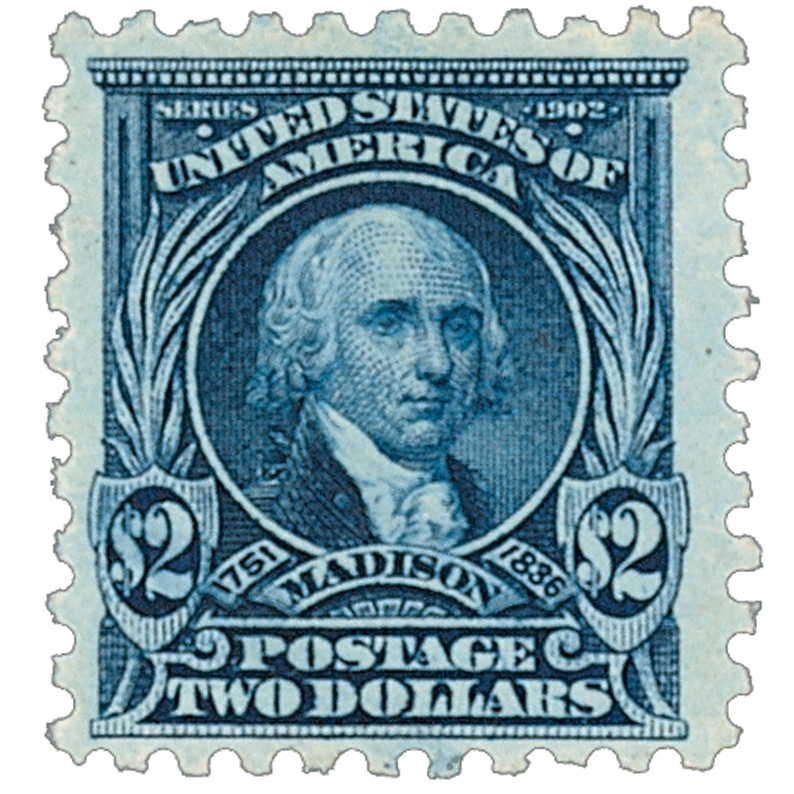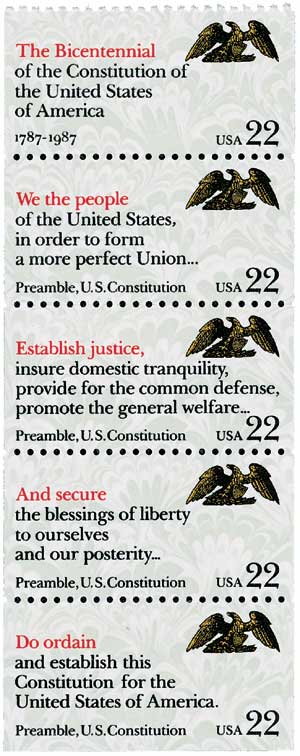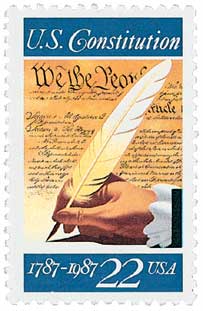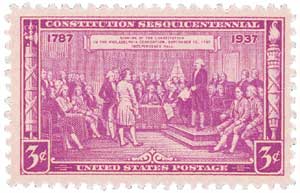
# 2355-59 FDC - 1987 22c Drafting the Constitution
Â
22¢ Drafting the Constitution
Booklet Stamps
City: Washington, DC
Quantity:Â 116,868,000
Printed By: Bureau of Engraving and Printing
Printing Method: Photogravure
Perforations: 10 horizontally
Color: Multicolored
Signing Of The U.S. Constitution
On September 17, 1787, 39 delegates from 12 states signed the U.S. Constitution, laying the groundwork of our nation’s government.
In the Spring of 1787, delegates from 12 of the 13 states (Rhode Island didn’t participate, they opposed a national government) met at Independence Hall in Philadelphia to amend the Articles of Confederation. The Constitutional Convention was set to open on May 4, but few of the delegates had arrived by that time. Though, one arrived early and eager – James Madison.

Madison was ready to share and implement his ideas to improve to the U.S. government. He arrived at the convention with a number of resources to share with his fellow delegates. Madison brought a paper on early and modern confederacies, and another explaining what he considered the strengths and weaknesses of the Articles of Confederation. His plan was to create a new central government with stronger powers, an elected chief executive with the power to veto legislation, a federal judiciary branch, and a two-chambered legislature. While each branch would have certain set responsibilities, they would each also have the opportunity to take part in checks and balances of each other’s actions.

Madison’s plan was an overwhelming success. The members of the convention drafted the new constitution based largely on his ideas and signed it on September 17, replacing the Articles of Confederation. In addition, he shared his Virginia Plan, which consisted of a House of Representatives (with the members from each state dependent on population) and a Senate (whose delegates would be elected by the House of Representatives) was utilized as the national hierarchy with one change. In the final plan, the number of Senators from each state would be the same, which differed slightly from Madison’s vision.

In order for the proposed constitution to take effect, at least nine out of 13 states needed to ratify it. Madison lobbied extensively to ensure the constitution’s passage. Along with Alexander Hamilton and John Jay, Madison published a series of 85 essays called “The Federalist Papers.†They explained in detail how the constitution would work. Madison is credited with writing 26 of these essays. Despite opposing arguments from Patrick Henry, James Monroe, and George Mason, the constitution was ratified by each state by 1790. The U.S. Constitution was now the supreme law of America.
Â
22¢ Drafting the Constitution
Booklet Stamps
City: Washington, DC
Quantity:Â 116,868,000
Printed By: Bureau of Engraving and Printing
Printing Method: Photogravure
Perforations: 10 horizontally
Color: Multicolored
Signing Of The U.S. Constitution
On September 17, 1787, 39 delegates from 12 states signed the U.S. Constitution, laying the groundwork of our nation’s government.
In the Spring of 1787, delegates from 12 of the 13 states (Rhode Island didn’t participate, they opposed a national government) met at Independence Hall in Philadelphia to amend the Articles of Confederation. The Constitutional Convention was set to open on May 4, but few of the delegates had arrived by that time. Though, one arrived early and eager – James Madison.

Madison was ready to share and implement his ideas to improve to the U.S. government. He arrived at the convention with a number of resources to share with his fellow delegates. Madison brought a paper on early and modern confederacies, and another explaining what he considered the strengths and weaknesses of the Articles of Confederation. His plan was to create a new central government with stronger powers, an elected chief executive with the power to veto legislation, a federal judiciary branch, and a two-chambered legislature. While each branch would have certain set responsibilities, they would each also have the opportunity to take part in checks and balances of each other’s actions.

Madison’s plan was an overwhelming success. The members of the convention drafted the new constitution based largely on his ideas and signed it on September 17, replacing the Articles of Confederation. In addition, he shared his Virginia Plan, which consisted of a House of Representatives (with the members from each state dependent on population) and a Senate (whose delegates would be elected by the House of Representatives) was utilized as the national hierarchy with one change. In the final plan, the number of Senators from each state would be the same, which differed slightly from Madison’s vision.

In order for the proposed constitution to take effect, at least nine out of 13 states needed to ratify it. Madison lobbied extensively to ensure the constitution’s passage. Along with Alexander Hamilton and John Jay, Madison published a series of 85 essays called “The Federalist Papers.†They explained in detail how the constitution would work. Madison is credited with writing 26 of these essays. Despite opposing arguments from Patrick Henry, James Monroe, and George Mason, the constitution was ratified by each state by 1790. The U.S. Constitution was now the supreme law of America.














